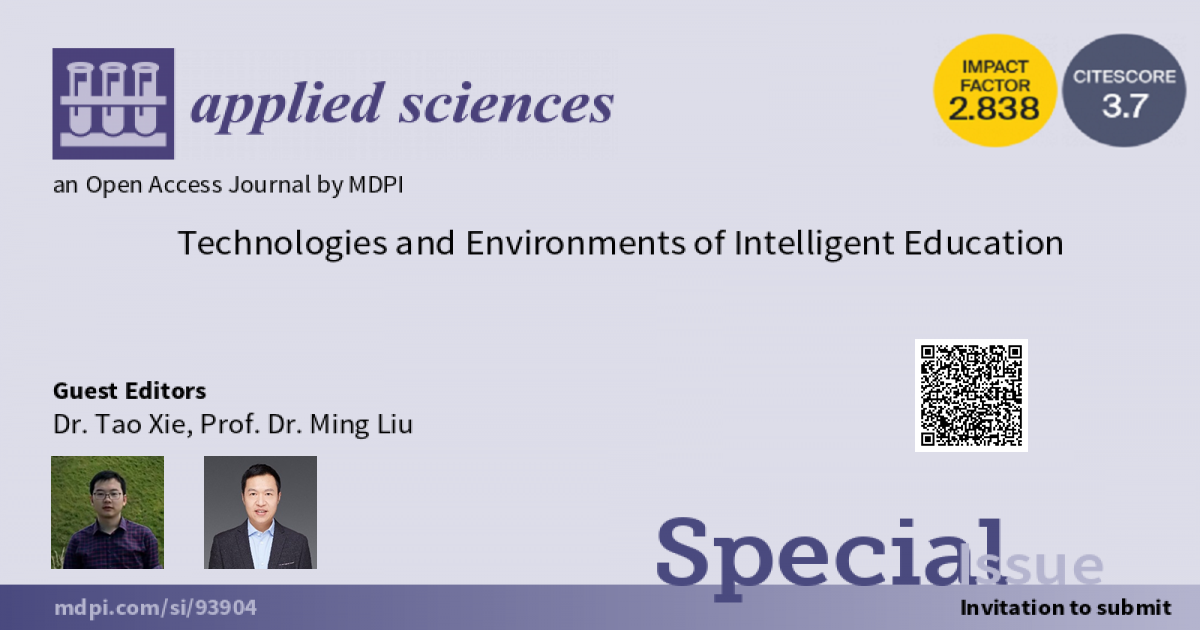Technologies and Environments of Intelligent Education
A special issue of Applied Sciences (ISSN 2076-3417). This special issue belongs to the section "Computing and Artificial Intelligence".
Deadline for manuscript submissions: closed (28 February 2023) | Viewed by 95936

Special Issue Editors
Interests: intelligent E-Learning environments; virtual reality in education; AI in education
Special Issues, Collections and Topics in MDPI journals
Special Issue Information
Dear Colleagues,
The new generation of information technology is giving great magical power to education. Many scholars are exploring new technologies, methods and application scenarios for optimizing educational outcomes. However, a large number of problems remain to be answered. For example, the ways in which new technologies empower personalized learning to improve students’ cognition, skills, and social communication have drawn extensive interests but still in its infancy in recent years. Such topic involves a mixed study of psychology, learning theory, and computation, where interdisciplinary research paradigm is becoming an important weapon in smart learning environment. Therefore, this Special Issue plans to give an overview of the most recent advances in the field of intelligent education and their applications.Potential topics include, but are not limited to:
- Artificial intelligence in education;
- Virtual reality in education;
- Mining and analysis of big educational data;
- Technologies for collaborative learning;
- Technology-enhanced personalized learning;
- Intelligent recommender systems;
- Applications and effect of intelligent learning environments and tools;
- Knowledge graph-based learning navigation.
Dr. Tao Xie
Prof. Dr. Ming Liu
Guest Editors
Manuscript Submission Information
Manuscripts should be submitted online at www.mdpi.com by registering and logging in to this website. Once you are registered, click here to go to the submission form. Manuscripts can be submitted until the deadline. All submissions that pass pre-check are peer-reviewed. Accepted papers will be published continuously in the journal (as soon as accepted) and will be listed together on the special issue website. Research articles, review articles as well as short communications are invited. For planned papers, a title and short abstract (about 250 words) can be sent to the Editorial Office for assessment.
Submitted manuscripts should not have been published previously, nor be under consideration for publication elsewhere (except conference proceedings papers). All manuscripts are thoroughly refereed through a single-blind peer-review process. A guide for authors and other relevant information for submission of manuscripts is available on the Instructions for Authors page. Applied Sciences is an international peer-reviewed open access semimonthly journal published by MDPI.
Please visit the Instructions for Authors page before submitting a manuscript. The Article Processing Charge (APC) for publication in this open access journal is 2400 CHF (Swiss Francs). Submitted papers should be well formatted and use good English. Authors may use MDPI's English editing service prior to publication or during author revisions.
Keywords
- intelligent education
- personalized learning, artificial intelligence
- virtual reality
- collaborative learning
Benefits of Publishing in a Special Issue
- Ease of navigation: Grouping papers by topic helps scholars navigate broad scope journals more efficiently.
- Greater discoverability: Special Issues support the reach and impact of scientific research. Articles in Special Issues are more discoverable and cited more frequently.
- Expansion of research network: Special Issues facilitate connections among authors, fostering scientific collaborations.
- External promotion: Articles in Special Issues are often promoted through the journal's social media, increasing their visibility.
- Reprint: MDPI Books provides the opportunity to republish successful Special Issues in book format, both online and in print.
Further information on MDPI's Special Issue policies can be found here.






